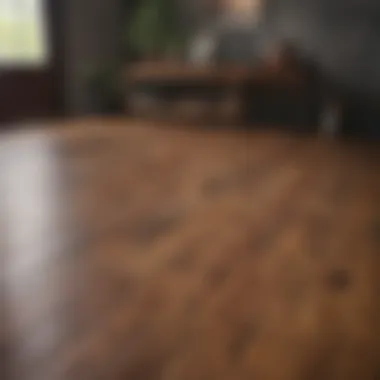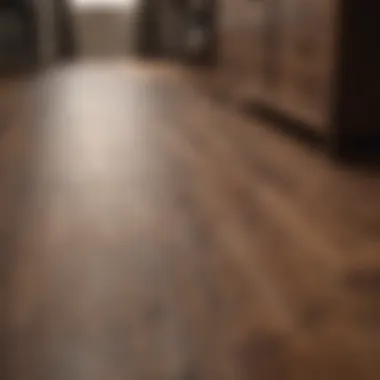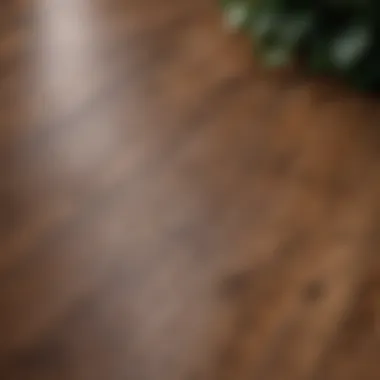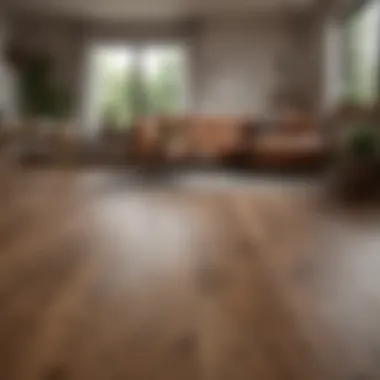Top Wood-Like Flooring Options for Your Home


Intro
In the evolving landscape of interior design, flooring choices have gained prominence. One key trend is the pursuit of materials that replicate the aesthetic of wood. Homeowners and renters alike seek flooring solutions that blend the warmth and natural appeal of wood with practical benefits such as durability and easy maintenance. This article explores several options like laminate, vinyl, and engineered hardwood, each offering unique advantages. We will also consider factors like installation processes, sustainability, and maintenance requirements, enabling informed decisions for personal spaces.
Design Inspiration
Current Trends in Interior Design
The current phase in interior design emphasizes comfort and functionality. Factors that influence flooring choice include the desire for eco-friendliness, cost-effectiveness, and versatility. People prefer materials that add character without compromising practicality. For many, the allure of wood persists, but real wood has its limitations, which is why alternatives are increasingly popular. Laminate and vinyl are leading options, presenting an attractive, wood-like appearance combined with functionality suitable for varied spaces.
Color Palettes That Transform Spaces
Color selection when choosing wood-look flooring impacts the overall aesthetics significantly. Darker shades such as espresso or walnut can create a sense of elegance, while lighter tones like maple or ash provide a more airy feel. Popular trends also lean towards gray tones, reflecting a modern touch that pairs effectively with contemporary furnishings. Additionally, integrating rugs and decor in contrasting colors elevates the design, making it visually appealing.
Choosing the right flooring color requires consideration of furniture and wall colors to ensure a harmonious space. Understanding how these elements align can greatly influence the overall look of a room.
Intro to Wood-Like Flooring
Flooring options that replicate the look of wood have become increasingly popular among homeowners and interior designers. The blend of aesthetics with practicality makes wood-like flooring an attractive choice for various applications. These alternatives present a solution for those who admire the warmth and natural beauty of wood but seek cost-effective or sustainable options. By exploring this topic, readers can better understand the advantages and limitations of these materials, ultimately informing their decisions about flooring choices.
Understanding the Appeal of Wood Aesthetics
Wood has long been cherished for its beauty. Its grain patterns and rich textures evoke a sense of comfort and elegance. Homeowners often desire the look of wood for its versatility, which complements a wide range of interior styles, from rustic to modern. However, maintaining genuine hardwood can be challenging, involving regular upkeep and careful treatment against scratches and moisture.
In contrast, wood-like flooring mimics these aesthetics while addressing some drawbacks of real wood. For many, the appeal lies in the ability to achieve a similar visual effect without compromising on durability or ease of maintenance. The advancement of technology allows for intricate designs that are both convincing and practical, catering to contemporary needs and expectations.
The Evolution of Flooring Materials
Flooring has undergone significant changes over the years. Initially, hardwood was the primary choice for homes, valued for its durability and classic appeal. However, other materials began to emerge as manufacturers sought to provide more options to consumer.
In the past few decades, technological innovations have led to developments in laminate, vinyl, and engineered hardwood—materials that offer visual likeness to wood while providing various advantages. The evolution reflects a growing awareness about sustainability, affordability, and maintenance. Some options, like bamboo, emphasize eco-friendliness, appealing to environmentally conscious buyers. Overall, this evolution addresses both aesthetic desires and functional needs.
"The transformation in flooring materials signifies a shift in consumer preferences towards hybrid solutions that deliver both beauty and practicality."
The exploration of wood-like flooring leads to a myriad of choices, each with its own characteristics and benefits. As these materials become ever more sophisticated, the possibility of achieving wood aesthetics without traditional drawbacks is now a reality.
Types of Flooring That Mimic Wood
The appeal of wood-like flooring is primarily its ability to offer the aesthetic charm of natural wood while presenting advantages of modern materials. Different types of flooring that mimic wood vary in construction, durability, costs, and aesthetic appeal. Knowing these varieties helps homeowners make educated choices according to their specific needs and preferences. With significant advancements in flooring technology, choices have become more varied, allowing for a wide selection that fits different budgets and styles.
Laminate Flooring
Construction and durability
Laminate flooring features a layered structure, which typically includes a base layer, a high-density core, and a top layer with a printed image of wood. This design enhances its durability, making it a popular choice for areas with high traffic. Its resistance to scratches and dents is notable, contributing to its long lifespan. For many homeowners, the construction of laminate flooring is appealing for its practicality, especially in family homes with children and pets.
Variety of finishes
One of the defining characteristics of laminate flooring is its extensive selection of finishes. Manufacturers offer an array of colors and textures that closely mimic the look of different types of wood. This variety allows homeowners to choose a design that complements their interior style without the cost of real wood. However, while finishes can look authentic, they may lack the depth and richness of genuine wood grains, which could affect the overall aesthetic appeal for some.
Cost-effectiveness


Cost is a major factor for many when choosing flooring. Laminate flooring is generally more affordable than hardwood options, making it attractive for budget-conscious buyers. While it may require replacement over time, the initial lower price point, paired with minimal maintenance costs, positions it as a practical choice. Nevertheless, potential buyers should consider the lifespan versus the investment, as cheaper laminate options may not offer the same durability as higher-end products.
Vinyl Flooring
Luxury vinyl plank (LVP)
Luxury vinyl plank, commonly referred to as LVP, has gained prominence in the flooring market for its remarkable similarity to natural wood. Composed of multiple layers, LVP features a high-resolution image layer combined with durable wear layers, creating an impressive resemblance to real hardwood. Given its appealing surfaces, LVP is becoming a favorite for homeowners seeking wood aesthetics without significant compromise on performance.
Durability and water resistance
Vinyl flooring stands out due to its resilience, particularly regarding water and moisture resistance. This characteristic makes LVP suitable for areas prone to spills or high humidity, such as kitchens and bathrooms. The durability of vinyl can withstand everyday wear and tear, making it an accessible floor option for busy households. However, while LVP is water-resistant, it is essential to use it correctly to avoid damage in extreme moisture conditions.
Design flexibility
Another key aspect of vinyl flooring is its design flexibility. Homeowners can find a vast selection of styles, colors, and patterns, including those that closely replicate various wood types. This flexibility allows for creative expression in interior design, accommodating individualized tastes and preferences. The downside, however, is that while vinyl can mimic wood, some variations may not capture the uniqueness of real hardwood, which might disappoint certain buyers.
Engineered Hardwood
Composition and layers
Engineered hardwood consists of multiple layers, with a top layer of genuine hardwood and an underlying composite structure. This combination offers stability and reduces susceptibility to changes in humidity and temperature. This feature makes engineered hardwood a popular choice for environments where traditional solid hardwood might warp or expand.
Real wood veneer advantages
The top layer of engineered hardwood is made from real wood, which allows for the genuine aesthetics of hardwood flooring. This unique advantage means that homeowners enjoy the beauty of natural wood while benefiting from enhanced durability and stability offered by the composite core. However, the cost can be higher compared to laminate and other synthetic options, which may deter some homeowners.
Installation options
There are various installation methods for engineered hardwood, including glue-down, nail-down, and floating installations. Homeowners can select their preferred method based on comfort and suitability for their specific environment. The floating option, for example, is often favored for its ease of installation, making it an appealing choice for DIY enthusiasts. Each installation method has its considerations, some requiring more skill and time than others.
Bamboo Flooring
Sustainability aspects
Bamboo flooring is increasingly favored for its eco-friendliness. Bamboo is a rapidly renewable resource that can be harvested with minimal environmental impact. This characteristic appeals to those looking to incorporate sustainable materials into their homes. Despite its benefits, not all bamboo flooring products meet the same standards of sustainability, so it is essential for consumers to select responsibly sourced options.
Hardness and resilience
Bamboo is known for its exceptional hardness, making it resistant to wear and tear, similar to oak and maple woods. This strength contributes to its appeal for high-traffic areas. However, potential buyers should be cautious as not all bamboo products maintain this toughness, and some lower-quality options can become easily damaged.
Color and style options
Bamboo offers a unique aesthetic with natural variations in color and grain, providing homeowners with different style choices. It is available in light and dark shades, accommodating a range of design preferences. Although the natural look of bamboo may appeal to many, some people may find the limited color options less attractive compared to traditional wood flooring alternatives.
Cork Flooring
Natural insulation properties
Cork flooring possesses natural insulating properties, providing comfort and warmth underfoot. This characteristic can be beneficial in homes where energy efficiency is a priority. Cork also has sound-absorbing qualities, which can help reduce noise levels, making it a practical choice for multi-story homes. However, cork may not be as durable in high-traffic areas, so its placement should be considered carefully.
Unique texture and aesthetics


The look and texture of cork flooring offer a distinct visual appeal. With its natural patterns and tactile surface, cork can add character to any room. While the unique aesthetic can be a selling point, some may find it does not align with traditional wood looks, affecting its attractiveness to specific audiences.
Environmental impact
Cork is sourced from the bark of cork oak trees, which can regenerate, making it a sustainable available material. The minimal impact of its harvesting process makes it appealing in the context of environmental awareness. However, the production process can vary, and it is important for consumers to investigate the sustainability compliance of their chosen cork flooring products.
Comparative Analysis of Flooring Options
A comparative analysis of flooring options serves as a crucial framework for making informed decisions about wood-like flooring. This section emphasizes various elements such as cost, installation processes, maintenance requirements, and environmental considerations. By examining these factors, homeowners and design enthusiasts can determine the most suitable flooring alternative based on their specific needs and aesthetic preferences.
Cost Comparison
When evaluating flooring options, cost is often the foremost consideration. Understanding the pricing dynamics of laminate, vinyl, engineered hardwood, bamboo, and cork is essential. Each product varies significantly in price.
- Laminate Flooring tends to be the most budget-friendly option, typically ranging from $1 to $4 per square foot.
- Vinyl Flooring, particularly luxury vinyl planks, falls within the range of $2 to $6 per square foot.
- Engineered Hardwood sees costs between $4 and $10 per square foot, depending on the wood used.
- Bamboo Flooring is often priced similarly to engineered hardwood, fluctuating between $3 and $8 per square foot.
- Cork Flooring can range from $3 to $6 per square foot.
Homeowners must also consider installation costs, as hiring professionals can add $2 to $5 per square foot. Additionally, it’s valuable to weigh long-term durability against initial pricing, as cheaper options may require replacement sooner than others.
Installation Process
The complexity of the installation process varies among different flooring types:
- Laminate and Vinyl Flooring often come with click-lock systems, making DIY installation feasible. This can save money on labor but requires careful attention to subfloor preparation.
- Engineered Hardwood typically requires professional installation due to the need for meticulous alignment and secure attachment methods.
- Bamboo Flooring can be installed in a similar manner to hardwood, demanding precision and skill.
- Cork Flooring is also installation sensitive and may require glue-down methods for durability.
Understanding these dynamics can greatly influence the overall project timeline and budget.
Maintenance Requirements
Different flooring materials demand varied maintenance effort.
- Laminate is known for its easy upkeep, requiring simple sweeping and occasional damp mopping.
- Vinyl Flooring is highly resistant to stains and spills, positioning it as an excellent option for households with pets or children.
- Engineered Hardwood, while beautiful, needs more maintenance, including regular refinishing to preserve its appearance over time.
- Bamboo is relatively easy to care for but can be sensitive to excessive moisture.
- Cork offers natural insulation properties and needs infrequent vacuuming and the occasional sealant application to combat wear.
When selecting flooring, understanding these maintenance demands can help homeowners forecast future upkeep efforts.
Environmental Considerations
Sustainability is becoming increasingly pivotal in flooring decisions. Each flooring option carries distinct environmental impacts:
- Laminate Flooring often contains recycled materials but may use adhesives that emit volatile organic compounds (VOCs).
- Vinyl Flooring, though durable, is frequently criticized for its environmental footprint due to the manufacturing process.
- Engineered Hardwood is considered more sustainable than solid hardwood, especially when sourced from certified sources.
- Bamboo is a rapidly renewable resource, making it an eco-friendly alternative, although caution should be taken with imported options due to questionable sustainability practices.
- Cork is harvested from the bark of trees without harming them, offering significant ecological benefits.
When selecting flooring materials, consider the entire lifecycle impact, from production to disposal.
Understanding the comprehensive comparative analysis empowers homeowners to align their flooring choices with economic considerations, aesthetic goals, and environmental ethos.
Aesthetic Considerations
Aesthetic considerations play a crucial role in determining the right flooring option for any space. Homeowners and designers often prioritize appearance because flooring significantly influences the overall look and feel of a room. The choice of flooring can complement or contrast existing elements such as furniture, walls, and decor. Thus, understanding what aesthetic values different flooring options offer can make all the difference in achieving a desired ambiance.
When it comes to wood-like flooring, aesthetics encompass several factors that deserve detailed exploration. Not only do these materials strive to imitate the organic charm of natural wood, but they also provide a vast range of styles, colors, and finishes. Understanding these elements ensures that decisions align with personal preferences and the functional aspects of the environment.
Color Variations and Finishes


Choosing the right color is essential for setting the tone of a space. Wood-like flooring is available in numerous shades, from rich dark browns to light blondes. These colors can create various atmospheres. For instance, dark hues often impart a sense of elegance and warmth, while lighter options can make a space appear larger and more open.
Finishing plays a critical role in the appearance of flooring. A high-gloss finish can lend a modern edge to a space, while a matte finish may create a more rustic and natural feeling. Here are notable points to consider when selecting color and finish:
- Light colors can help in rooms with limited natural light, enhancing brightness.
- Dark colors add depth and sophistication.
- Textured finishes can overcome the sometimes flat appearance of other flooring types.
- Glossy finishes reflect light, potentially enhancing the perception of space.
"The finish of your flooring can significantly impact the aesthetic outcome of your interior design."
By mixing and matching shades and finishes, homeowners can tailor their choices to achieve precisely the desired effect.
Textures and Patterns
Texture and pattern are additional layers that contribute to a room’s design. Wood-like flooring options offer a diverse range of textures—from smooth to deeply grained surfaces. Texture influences both visual and tactile experiences. A rustic finish might display knots and organic patterns, invoking a sense of nature, while sleek patterns contribute to a modern look.
Consideration of texture can enhance the aesthetic experience in the following ways:
- Natural textures create a comforting ambiance, promoting a connection to nature.
- Smooth textures resonate with contemporary designs, emphasizing minimalism.
- Patterns, such as herringbone or chevron, can introduce visual interest that draws the eye across the floor space.
Additionally, certain flooring options like laminate or vinyl can be printed with intricate patterns that may emulate the irregularities found in real wood. This aspect allows for creativity in how flooring is used throughout spaces, setting the tone of both commercial and residential environments.
By thoughtfully considering color, finish, texture, and patterns, one can transform any room into a truly inviting and beautiful space.
Potential Applications of Wood-Like Flooring
The adoption of wood-like flooring in various settings enhances both the visual appeal and practical functionality of spaces. This section focuses on how such flooring is not limited to design preferences but also aligns with the unique demands of different environments. Understanding these applications informs informed decisions for homeowners, renters, and commercial property owners alike.
Key Rooms for Implementation
Certain rooms within a home or business are naturally more conducive to the implementation of wood-like flooring. Consider the following:
- Living Rooms: This space generally acts as the central hub for family activities. The warmth and inviting nature of wood-like flooring enhance this atmosphere. Choices such as engineered hardwood or laminate can create an aesthetic that feels both modern and timeless.
- Kitchens: Here, flooring must be durable and easy to clean. Luxury vinyl plank flooring is a strong candidate as it offers a wood-like appearance while resisting moisture damage and stains.
- Bathrooms: While traditional hardwood does not fare well in high humidity, vinyl options mimic wood without the absorption problems. Such practical solutions maintain the desired aesthetic while ensuring longevity.
- Hallways and Entry Areas: These high-traffic zones benefit from robust flooring choices. Laminate and cork are excellent due to their resistance to wear and tear, providing style without sacrificing function.
The selection of appropriate flooring types for these spaces reflects a balance between visual preference and functional necessity.
Commercial vs. Residential Uses
The application of wood-like flooring extends beyond residential environments. In commercial spaces, the needs vary considerably. Here are several points to consider:
- Residential Spaces: Homeowners often prioritize aesthetics since a home's appearance can reflect personal style. Spaces like living rooms, bedrooms, and even home offices become foundations for expression.
- Commercial Spaces: Businesses may prioritize durability and maintenance. For example, luxury vinyl flooring in retail stores can withstand high foot traffic while providing a stylish welcoming environment. In restaurants, the choice of wood-like flooring can create a certain ambiance while also ensuring easy cleanup.
Both contexts underscore the importance of selecting flooring that aligns with specific needs and expectations.
"The right flooring choice can define the essence of both a home and a business environment, merging practicality with style."
Closure
Final Recommendations
When choosing flooring that replicates wood, consider the following recommendations:
- Evaluate Your Space: Assess the rooms where the flooring will be installed. High-traffic areas may benefit from more durable materials like luxury vinyl plank, whereas bedrooms might suit softer options such as laminate.
- Budget Wisely: Analyze the cost implications of your choice. Laminate is often the most budget-friendly option, while engineered hardwood may offer a more affluent appearance at a higher price.
- Prioritize Maintenance: Think about the time and effort you are willing to invest in maintenance. Vinyl flooring usually offers superior resistance to water and stains, making it suitable for kitchens and bathrooms.
- Choose Eco-Friendly Options: Sustainable choices like bamboo and cork not only enhance your home’s aesthetics but also contribute positively to environmental conservation.
Future Trends in Flooring Technologies
The flooring industry is rapidly evolving, influenced by advancements in technology and changing consumer preferences. Key trends that are emerging include:
- Smart Flooring: Integrating technology in flooring is becoming more prevalent. Expect options that monitor foot traffic, temperature, or even health metrics, adding a layer of connectivity and convenience.
- Enhanced Durability: Innovations in manufacturing processes will likely lead to even more resilient flooring options that can withstand scratches, stains, and moisture, offering longer lifespans.
- Sustainable Practices: As environmental awareness grows, more companies are exploring sustainable materials and eco-friendly production methods that reduce carbon footprints.
- Customization: The trend towards personalization is strong. Flooring that can be customized in terms of color, texture, and patterns might become standard, allowing homeowners to create unique spaces that reflect their individual tastes.
By understanding these aspects, you can navigate the diverse world of wood-like flooring effectively and make choices that satisfy both your design aspirations and practical requirements.



